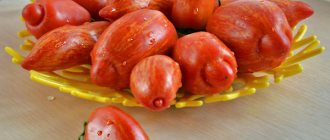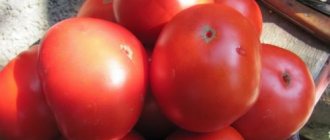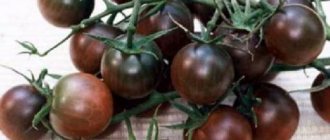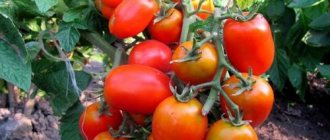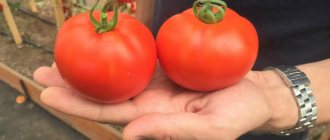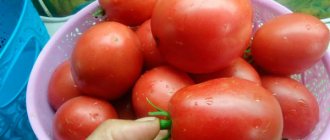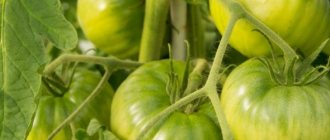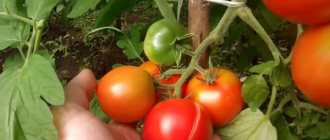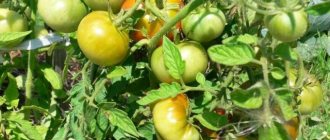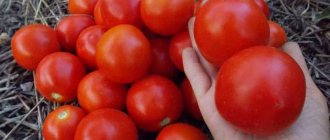Description and characteristics of the variety
Tomato Puzata Khata, characteristics and description of the variety presented in our article, is gaining popularity among gardeners. This variety was bred in 2012 by a Russian group led by Vladimir Kachainik. In 2013, the variety was included in the State Register.
According to the description, the Puzata Khata tomato variety is suitable for growing in open ground throughout Russia, however, in many regions of the country it is still recommended to plant it in greenhouses or use temporary film cover. According to reviews from gardeners who grew these tomatoes in open ground in the middle zone, the tomatoes may not ripen completely or will be smaller than the stated size. But in the southern regions, this variety grows well in open ground, the main thing is to adhere to the correct agricultural cultivation techniques.
In the State Register, the Puzata Khata tomato is recorded as early ripening and, according to its characteristics, the fruits should ripen 100 days from the moment of emergence, however, practice has shown that tomatoes turn red very slowly and with a great delay. Most likely, this variety is dependent on weather conditions, air temperature and the amount of sunlight, which it lacks in mid-latitudes.
Important! Due to long fruiting, tomatoes are harvested until frost, especially in greenhouse conditions, when it is possible to use additional heating.
Puzata Khata tomatoes are resistant to late blight and other diseases of this crop even with minimal preventive procedures.
But it’s worth paying attention to the composition of the soil. It must be balanced in terms of the content of basic nutrients, otherwise it will not be possible to harvest a bountiful harvest of delicious tomatoes.
- An early-ripening variety, the first fruits ripen 95-100 days after emergence.
- Indeterminate, has unlimited growth.
Interesting! In practice, according to reviews from gardeners, the bushes do not grow above 170 cm even in greenhouse conditions.
- The stems are thin and not powerful, so they need to be tied to a trellis so that the branches do not break under the weight of the fruit.
- It is necessary to pinch and shape the bush.
- Medium foliage and branching. The leaves are dark green.
- The root system is powerful, strong, pivotal.
- This variety is responsive to fertilizing, like all tomatoes.
- Productivity is high, from 1 sq. m harvest 9-11 kg of tomatoes.
- Up to 5 fruits are formed on one brush.
Diseases and pests
The variety is not too susceptible to diseases, but preventive measures should not be neglected. Before planting, the soil is spilled with a solution of potassium permanganate or copper sulfate. To prevent root rot, the soil can be mulched with straw, humus or peat.
Attention! During the late blight epidemic, plantings are treated with copper-containing preparations.
Regular inspections and preventive spraying with a weak solution of potassium permanganate can protect plantings from insect pests. Warm soapy water, which is used to wash the affected parts of the plants, helps against aphids. Thrips, whiteflies and spider mites are destroyed using industrial means or a decoction of celandine. When the Colorado potato beetle appears, larvae and adults are collected manually in small planting areas or other control methods are used.
Puzata “Khata” is an interesting and promising variety that deserves the attention of amateur gardeners. It is very responsive to care, the yield remains stable even in unfavorable weather conditions.
Blackleg
Dangerous fungal disease. It mainly affects seedlings and young immature plants. In most cases, the pathogen is introduced with poorly treated soil. If the growing conditions are met, the fungus does not manifest itself in any way. But when humidity rises, the fungus wakes up and begins to multiply rapidly. As a result, the root collar of the seedlings is damaged and they die.
Affected plants look as if someone has chewed them off near the surface of the soil. A photo of typical lesions is presented below. Fungicides are used to control blackleg. But in the phase of active spread of the disease, they are almost useless. The best protection against blackleg is timely prevention.
Pests
Even if the growing conditions are observed, in some unfavorable years, tomatoes can suffer from insect pests.
Aphid
A small sucking pest, depending on the species it can be black or green. It feeds on the juice of young shoots and leaves. With severe damage, plants begin to experience nutritional deficiency, resulting in the shedding of leaves and ovaries. Garden ants contribute to the active spread of aphids. Therefore, the fight should begin with their destruction. Insecticides used for treatment:
- Commander,
- Aktara,
- Tanrek.
They are bred in strict accordance with the attached instructions. In most cases, a single treatment is sufficient. In case of severe infection, tomatoes are sprayed twice with an interval of 10 days.
Whitefly
Small sucking pest. Actively damages all parts of plants. Due to its very small size, its spread is noticed only at the stage of severe infection. Seedlings and adult plants can suffer from whitefly. To destroy the insect, systemic insecticides are used: Aktara, Komandor, Tanrek. Depending on the degree of infection, treatment is carried out 2-3 times.
Fruit characteristics
- The unripe fruits are light green in color without the blemishes at the base common to many varieties. Ripe tomatoes are red with an orange tint.
- The skin is dense, the tomatoes do not crack. Voids often form inside, so the fruits are not very suitable for canning.
- The fruit consists of 4-6 seed chambers.
- The pulp is fleshy, juicy, tender, there are few seeds.
- The tomatoes are large. The average fruit weight is 250-300 g, but can reach 700-800 g. The largest are the first fruits formed on the bush. Subsequent ones gradually become smaller.
Important! The size of Puzata Khata tomatoes depends on weather conditions, the formation of the bush, fertilizers applied to the soil, and even on the density of plantings.
- Tomatoes store well and withstand transportation.
- You can collect greenish fruits; they ripen well outside the bush, while maintaining their taste and external characteristics.
Mr. Summer Resident recommends: Puzata Khata tomato - a dietary dish
Puzata Khata contains a large amount of glucose and other useful substances. At the same time, tomatoes have a minimal amount of acid. They are allowed to be eaten while following the dietary table, and included in the children's diet.
The fruits are recognized as universal. They can be consumed in any form: canned, raw, or added to salads. Tomatoes make delicious juice; they do not lose their taste after heat treatment.
Reviews about the variety are both positive and negative. Moreover, the opinion of gardeners is radically different. For example, some claim that a lot of fruits ripen on the bushes, others say that the crop produces virtually no harvest and simply takes up extra space in the garden bed. Some describe the tomatoes as tender, very tasty and juicy, while others say that the tomatoes are unleavened and are only suitable for pickling and pickling.
Indeed, the characteristics of a variety in some cases may not coincide with the official description. The harvest largely depends on soil fertility, climatic conditions, compliance with care recommendations, etc. To understand whether a tomato is suitable for growing in a certain garden plot, you need to try planting several bushes and look at the speed of their development and fruiting. To obtain maximum results, you must follow the rules of maintenance and planting described earlier.
Photo
see what the Puzata Khata tomato variety in the photo below
Advantages and disadvantages
- High yield, as gardeners say, they harvest even more kg of tomatoes than stated in the official description of the variety.
- Contains a lot of sugar and healthy elements.
- Keeping quality.
- Large, unusual shape.
- Resistant to major crop diseases.
Flaws:
This variety, like others, has certain disadvantages, which include the following:
- They require shaping and gartering of the bush.
- The mail should be fertile and balanced in essential nutrients.
Features of cultivation
It is necessary to sow seeds for seedlings 60-65 days before planting the bushes in the ground. After the seedlings have 2-3 true leaves, pick them. After 7-10 days, the seedlings will need to be fed. Planting in a greenhouse is carried out from mid-May to June, when the soil has completely warmed up. Scheme - for 1 sq. m plant 3-4 bushes.
They are planted in open ground 1-2 weeks later than in a greenhouse, according to the same scheme. In the first days of planting, it is better to keep it under film.
More information about growing tomatoes is described in the article: Technology of growing tomatoes. Secrets of planting and care.
You might be interested in: How to properly plant tomatoes in a greenhouse: bush formation diagram, care features, photos and videos
Useful information: How to properly tie tomatoes in open ground: the best methods, step-by-step photo and video instructions
Agrotechnical techniques for growing tomatoes
Puzata Khata tomatoes begin to be sown in March; you can start preparing seedlings in early April. Seeds tested for germination must be disinfected. This procedure can be carried out using a special product that is sold in specialized stores, or you can use the old method - soak it in an aqueous solution of potassium permanganate.
Before the sowing procedure, it is necessary to prepare convenient containers and soil. The soil should be light, soft, fertile. When sowing, the seeds are deepened by 2 cm, and a small layer of aged humus is distributed over the planting material. Well-moistened containers with plantings are covered with paper or plastic wrap and placed in a warm place. In a few days the first shoots will begin to emerge. At this moment, the film is removed and the box with seedlings is placed in a well-lit place.
Tomatoes belong to heat-loving crops, so it is necessary to grow seedlings at a temperature of +24...25°C. As soon as the first strong leaves grow on the sprouts, it is worth replanting the plants. It is better to prepare a separate glass for each bush; peat containers are suitable.
The period of seedling growth before transplanting tomatoes into the ground should be at least two months. During this time, fertilizing is carried out 2-3 times; tomatoes are responsive to organic fertilizers and grow well after adding potassium, phosphorus and nitrogen to the soil. It is worth remembering that vegetable crops should be watered only with warm water, at the root. Moderate watering, timely fertilizing, proper thermal conditions and good lighting will help grow healthy seedlings.
In the second half of May and early June, soil preparation and planting of grown seedlings begins. The earth should warm up well; wood ash, humus and complex fertilizers are added to each hole for tomatoes. To disinfect the holes, you can use an aqueous solution of potassium permanganate.
It is better to place plants in a greenhouse or in open ground at the rate of 3-4 bushes per 1 m². A week before transplanting, young tomatoes are hardened and taken out several times for short periods of time in a cool place.
It is better to transplant vegetables to a permanent place of growth on a gloomy, non-sunny day. After digging and watering the seedlings, you need to take care of shading the bushes. This measure will help the crop to take root better; the formation of the bush is carried out immediately after transplantation.
After the first cluster, stepchildren are excluded; for good fruiting, it is enough to leave 8-9 clusters. The stems are attached to trellises or high stakes. During the growth period, heavy clusters of fruits are formed, and they are also fixed on supports.
Fertilizing is carried out after two weeks; aqueous solutions of mineral complexes and organic matter (mullein, bird droppings) are added to the root. Superphosphate can be used as a foliar additive.
Tomatoes usually do not suffer from unpleasant diseases, but any plant will become stronger if preventative measures are taken. To do this, it is recommended to regularly destroy weeds, ventilate the greenhouse, rid plants of excess foliage and promptly loosen the soil under the bushes.
